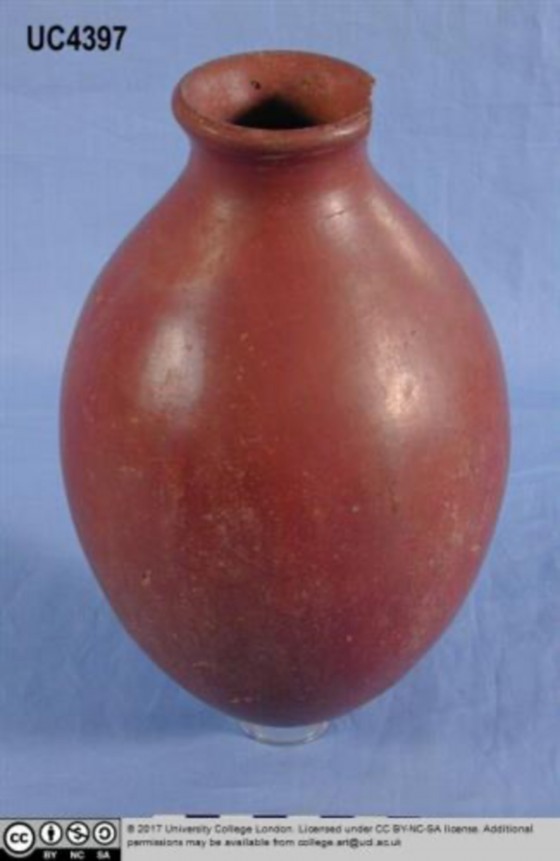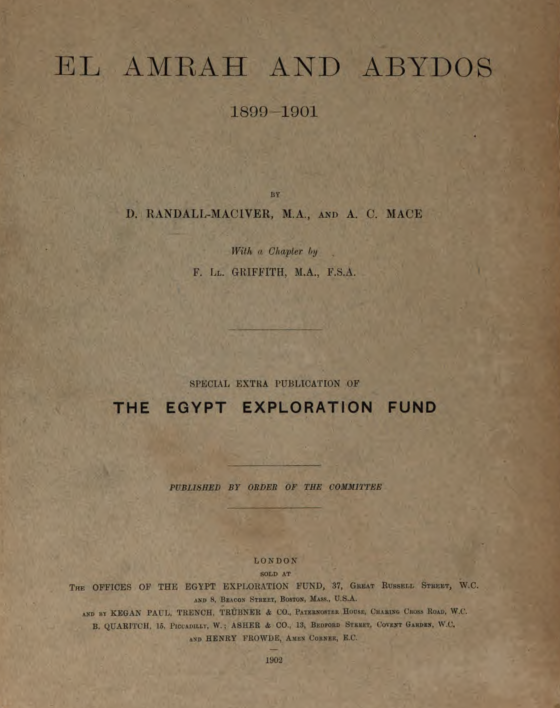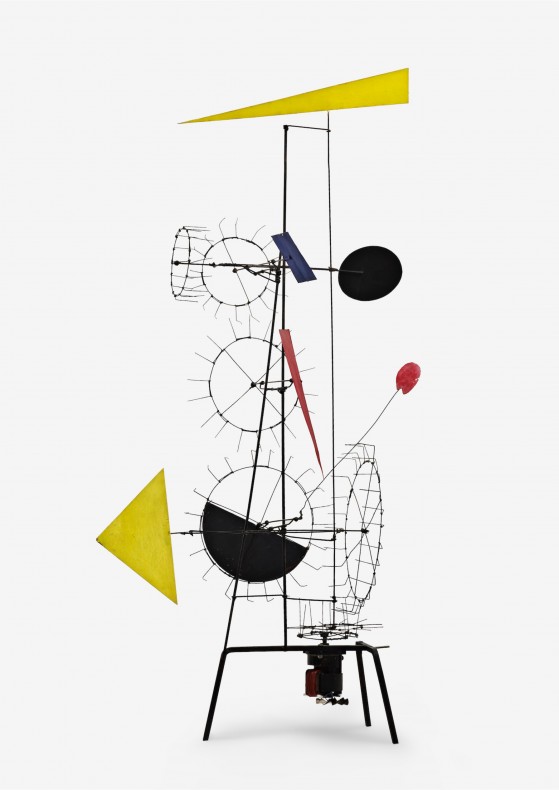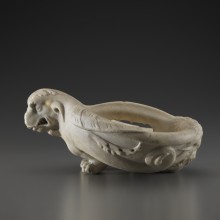
July 2023 Archaeology
A Predynastic Jar
Very early on, even before the onset of the 4th millennium BC, the inhabitants of the banks of the Nile developed a perfectly mastered ceramic technique, enabling them to produce creations of breathtaking aestheticism and quality.
This red vase is made from Nile clay and has a shape of astonishing simplicity and purity not dissimilar to modern art productions, to the extent that it blurs the chronological gap that separates us from our distant ancestors. Contemplating such an object, however simple at first glance, gives rise to particular and powerful emotions. From a scientific point of view, this type of artefact preserves a wealth of information, both technical and chronological, that is extremely useful to archaeologists.
See the artwork in the collectionBlack-topped predynastic jar
Egypt, el-Amra (Abydos region), cemetery « a »
Predynastic period, Naqada II (ca. 3500 – 3400 BC)
Nile clay with hematite slip
35,5 cm high, 19,3 cm diameter
FGA-ARCH-EG-0339
Provenance
Excavation directed by David Randall-MacIver and Anthony Wilkin at el-Amra under the auspices of the Egypt Exploration Fund 1900-1901;
Private collection, France ;
Purchased from galerie David Ghezelbash Archéologie, Paris, 14.09.2009.

Predynastic Egypt, the twilight of prehistory
The jar presented here was made in Egypt and dates from a very remote period, which modern researchers describe as "predynastic". This term, by definition, refers to the period that preceded the dynasties of pharaohs that succeeded one another for more than 3,000 years in Egypt. However, it is restricted to the 4th millennium BC, even though the banks of the Nile had been inhabited long before, with complex cultures having developed there earlier. This ancient Egypt does not yet resemble the much better-known Egypt of the historical epoch: the invention of the hieroglyphic writing and stone architecture did not take place until much later, and neither did the political unification of the country.
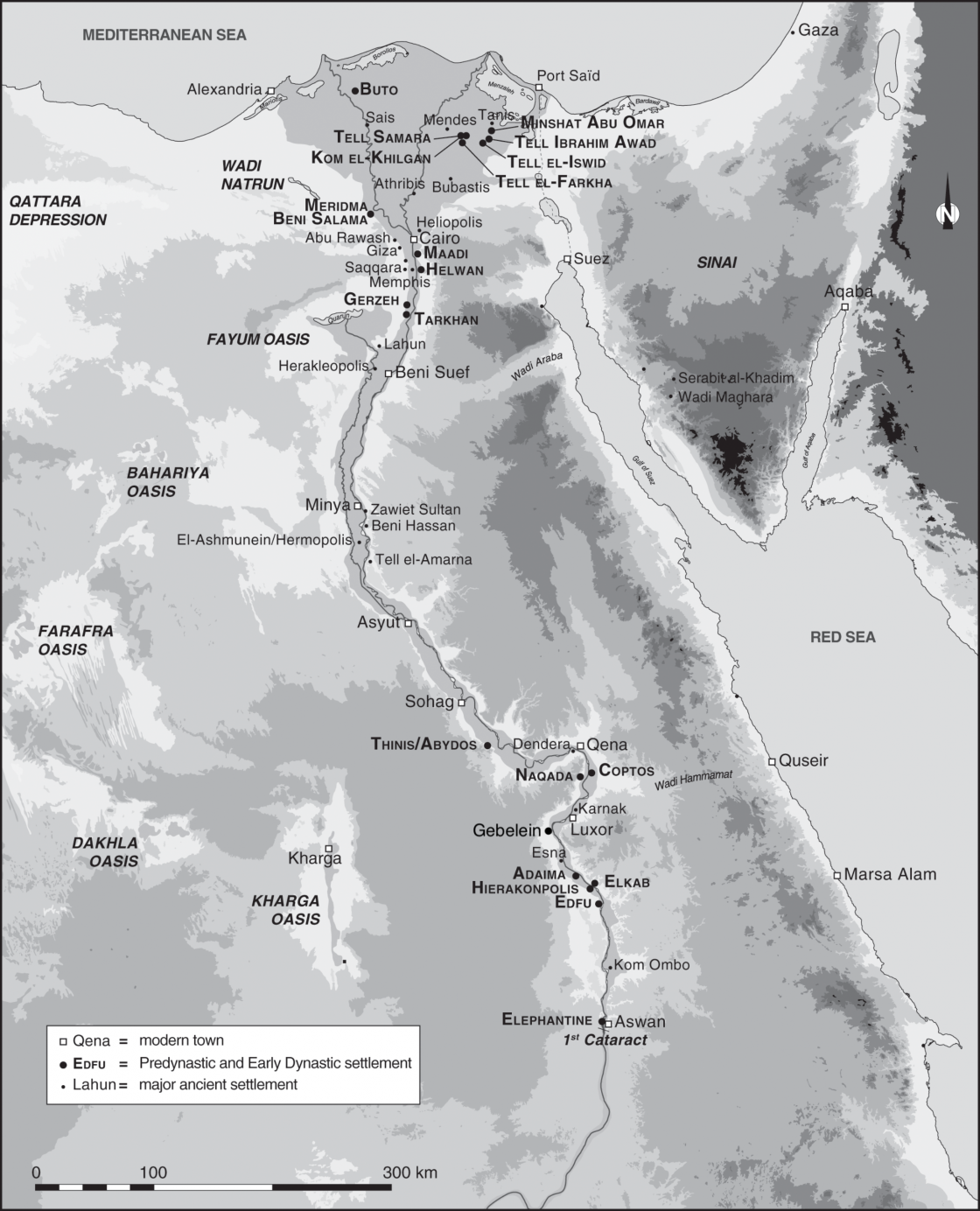
During this predynastic period, several kingdoms co-existed on the banks of the Nile, each ruled by a "chief" or "proto-king" who reigned over a limited portion of the valley from his capital city. These urban settlements include Hierakonpolis, Abydos, Naqada and Gebelein (Fig. 2). The discovery of Egyptian prehistory dates to the excavation carried out by British archaeologist William M.F. Petrie at Naqada in 1894-1895; since then, archaeological research has vastly focused on predynastic necropolises, to the detriment on settlement sites. The result is an imbalance between our knowledge of the funerary world and that of the living, so that our understanding of Predynastic Egypt suffers from a clear bias. Fortunately, modern archaeology is also investigating ancient habitat sites, but the development of modern towns and agriculture has often heavily damaged, if not thoroughly destroyed, most these ancient sites.
Data collected in the cemeteries therefore remains of importance, especially since many burials excavated during the pioneering period of the late 19th – early 20th century were very well preserved, with their funerary assemblage still in its original position (fig. 3).
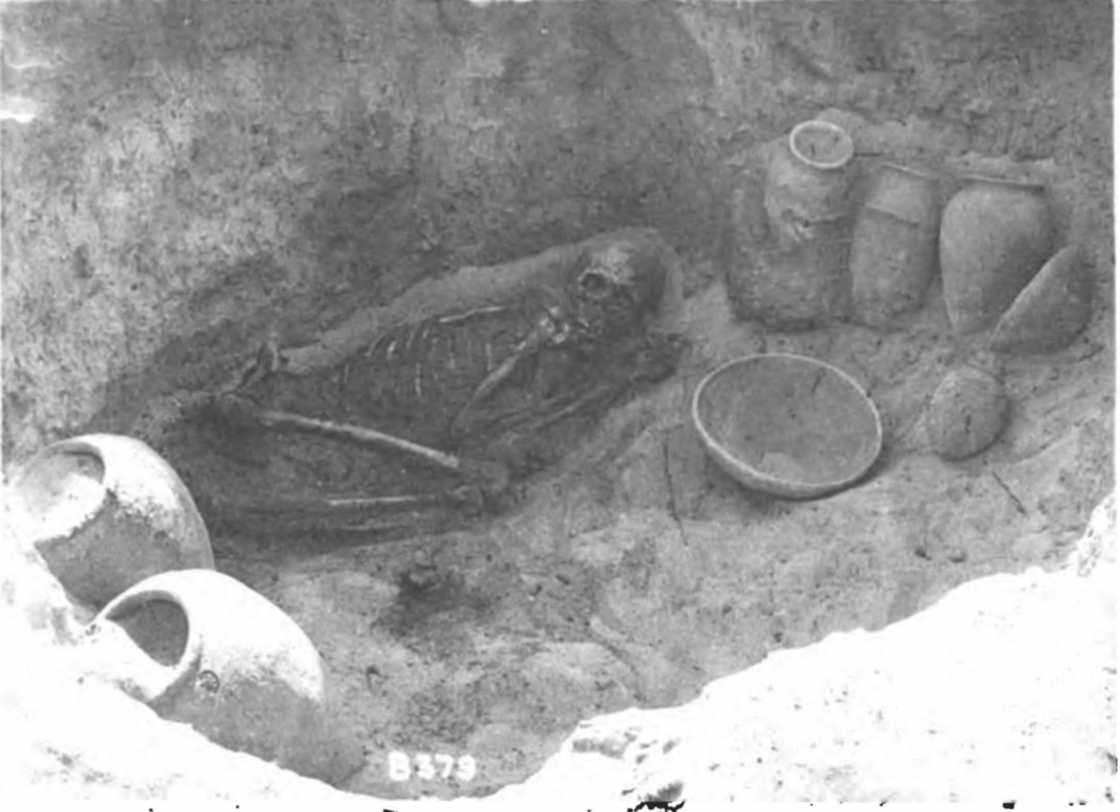
Predynastic fine-ware ceramics: a technological wonder
The black-topped jar from the Fondation belongs to a very specific category of Predynastic ceramics. At this time, so-called ‘rough-ware’ vessels were produced; their paste was coarse and contained an organic degreasing agent or temper that gave the surface an irregular finish (Fig. 4). These jars could be used, for example, for cooking or storing cereals and beer, and were probably the most widely available.
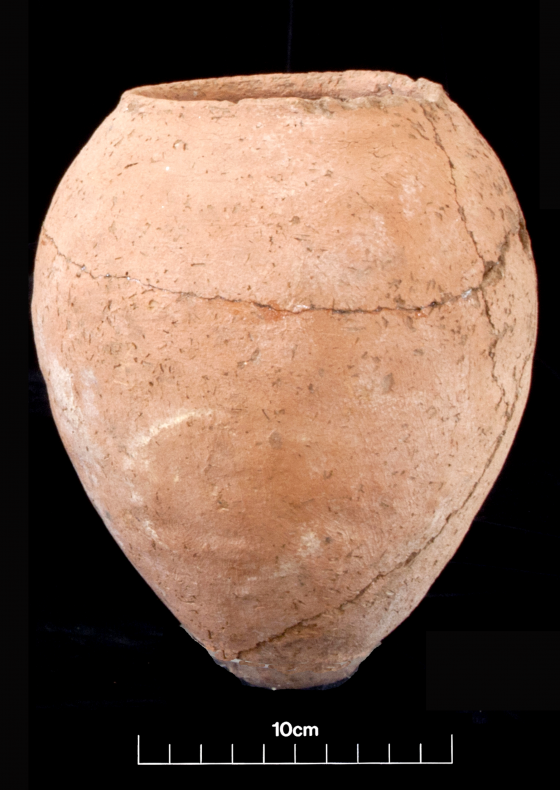
At the same time, potters developed a different technology: they produced so-called 'fine-ware' ceramics, using untempered Nile clay. After having shaped the vessel, they left it to dry, but only until the surface was leather-hard. They then polished it and covered it with a haematite-based slip that becomes bright red during the firing process in the kiln (fig. 5).
A second type of fine-ware ceramics is even more spectacular, although the exact method of production remains uncertain: red-polished vessel with a black rim. The jar in the Fondation (fig. 6a) belongs to this type. Contrary to what one might expect, this appearance was not achieved by applying black paint or pigment to an otherwise red vase. This black, or sometimes silver, colouring was obtained by reducing the oxygen content during the firing. This was done either during the initial firing or during a second kiln run. What is certain is that the vase had to be placed upside down in the kiln, partly buried in ash or organic matter, which altered the amount of oxygen in contact with the surface. This production of two-coloured ceramics, which could take a wide variety of shapes, is a typical feature of Egyptian Predynastic pottery. In rare cases, geometric or figurative decoration could be added to these vessels (fig. 6b), but this was almost exclusively the case for the entirely red ones (fig. 6c).
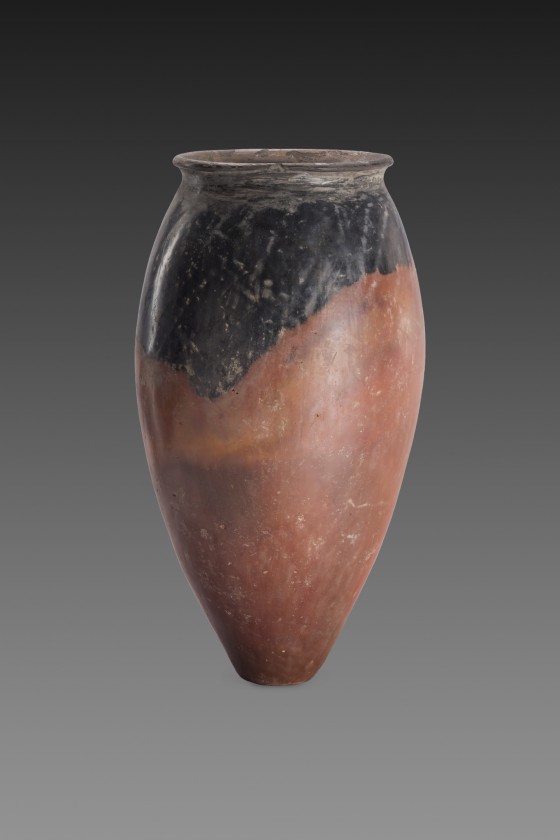

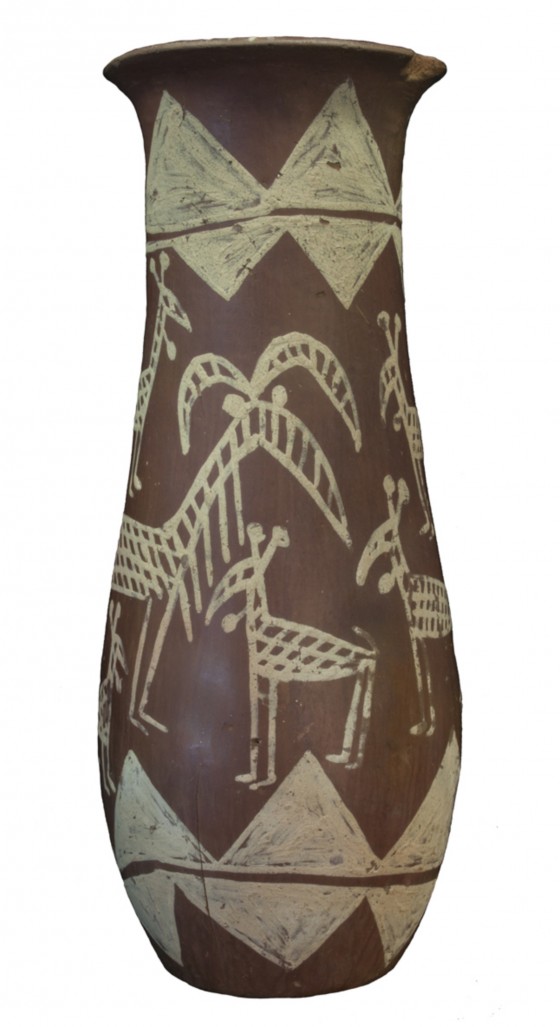
A single letter as proof of provenance
At the time the FGA jar was acquired in 2009, its archaeological provenance was unknown. However, a mark traced in black ink is clearly visible: a simple letter "a", which conceals a crucial piece of information (fig. 7a)! For a specialist in Predynastic Egypt, this immediately suggests a cemetery excavated in the years 1900-1901 in the region of Abydos in Upper Egypt. The famous archaeologist W.M.F. Petrie was leading excavations there on behalf of the Egypt Exploration Fund, and he asked his young compatriot David Randall-MacIver to investigate the el-Amra area. There, he uncovered two prehistoric cemeteries, one of which he named "a" and the other "b". In both cases, he used a lower-case letter, an important detail given that it was often capital letters that were chosen by excavators (see Fig. 2, above, showing a grave in cemetery "B" at Abadiyeh).
However, how can we be sure that the letter painted on the vessel actually refers to this specific cemetery, and rule out the possibility that it is a mark left, for example, by a previous collector? Close examination of the surface of the object reveals another inscription, partly erased: a large letter "a" written in pencil (fig. 7b). While this may be a little puzzling, we do know that it refers to a system developed by W.M.F. Petrie for the rapid recording of objects discovered during excavations: in the field, to save time, the place of discovery was written on the objects in pencil. When an artefact came from a tomb, the number of that tomb was written down; when it was found on the surface or in a context disturbed by looters, only the cemetery would be specified, which seems to be the case here. Later, often at the end of the day, the finds brought back to the dig house (fig. 8) were marked in black ink, often by the team-mates of the mission directors, or by their wives.
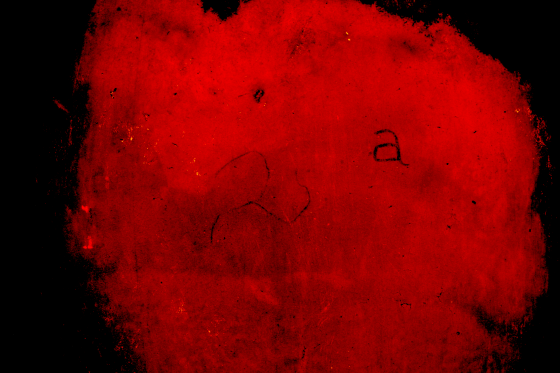
Seemingly insignificant, and unnoticed to this day, this simple letter restores a geographical origin to the object, for wants of a specific archaeological context. The two cemeteries excavated at el-Amra contained more than 1,000 tombs (600 in cemetery "a" and 400 tombs in cemetery "b"). However, it is possible that they originally formed a single, vast necropolis. Randall-MacIver devoted a monograph to this site (fig. 9), which, according to the standards of the time, included detailed text and numerous illustrations, but did not list each and every artefact discovered in the course of the work, focusing on the more important ones and on the better preserved tombs.

Show me a vessel, I will give you a date
As well as being remarkably aesthetic, Predynastic ceramics are a crucial asset for archaeologists. Since writing had not yet been invented, the chronology of the 4th millennium BC cannot be reconstructed from inscriptions in the same way as the historical era. For a long time, we could only base our understanding of the temporal development of these ancient periods on the study of the material culture uncovered during excavations. This was not an easy task, and the famous William Matthew Flinders Petrie himself did not immediately recognise that the prehistory he had uncovered was, in fact, prehistoric.
A few years before turning his attention to the region of Abydos, he undertook a colossal excavation in the winter of 1894-1895 near the village of Naqada, further south. With his team, he uncovered more than 2,300 tombs in three months, and was confronted with material that was highly unusual for Egypt, having himself only encountered it occasionally the previous year. He attributed all this material to a "new race" (sic), which would have invaded this region of Egypt in historic times. His French colleague Jacques de Morgan was the first to recognise that this was indeed prehistoric material. After agreeing with de Morgan, albeit probably grudgingly, Petrie made up for his error in a remarkable way: he closely studied thousands of ceramic vessels and succeeded in establishing a relative chronology of the Predynastic period based on the evolution of shapes and their association in burials, using an ingenious paper grid system of slips, in a way the precursor of the computer tabulator (fig. 10).


Using this system, Petrie divided the Predynastic period into three major phases, which he named according to the major sites excavated (el-Amra, Gerzeh, and Semaineh); they were further subdivided into 54 "sequential dates (SD)". Surprisingly, Naqada, the birthplace of Egyptian prehistory, did not feature. During the 20thcentury, other specialists examined this chronology and proposed revisions based on different methodological approaches and new discoveries. At present, Stan Hendrickx's chronology is the one generally followed: it has enabled Naqada to regain its importance for the predynastic period, since he has named each phase in relation to this major site. More recently, scientific analyses carried out by a team at the University of Oxford around ten years ago have made it possible to link relative chronologies to absolute dates determined by Carbon 14 measurements (fig. 11).
The shape of the FGA jar indicates that it was probably made during the Naqada IIC-IID phase of S. Hendrickx's relative chronology. It is difficult to be more precise in the absence of a preserved archaeological context, but this does allow us to date it to around 3500-3400 BC.
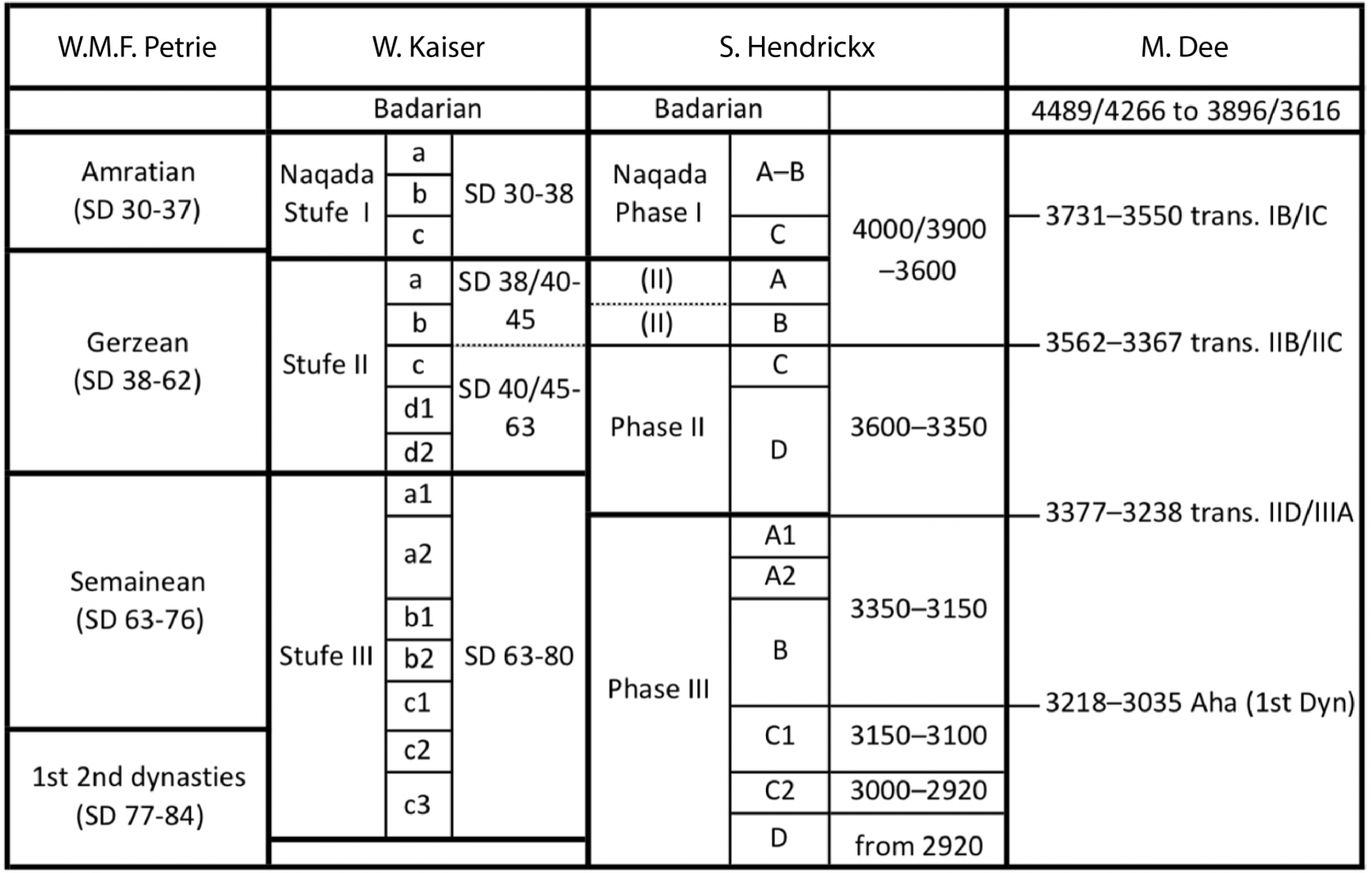
Dr Xavier Droux
Curator, Archaeology collection
Fondation Gandur pour l'Art, July 2023

